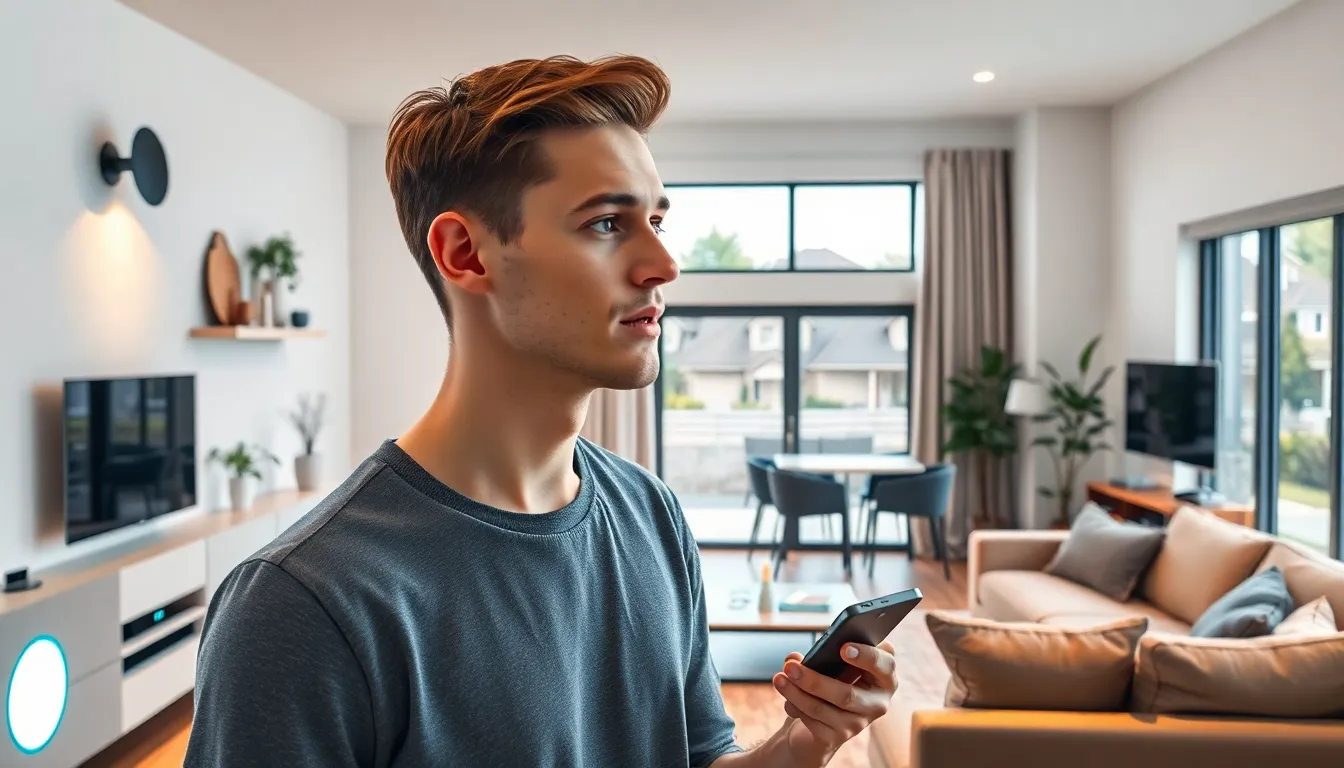Imagine a world where your home knows you better than your best friend. Smart homes are no longer just a futuristic dream; they’re quickly becoming a reality. With voice-activated assistants, automated lighting, and energy-efficient appliances, living in a smart home feels like having a personal butler who never complains about the laundry.
As technology evolves, the future of smart homes promises even more exciting innovations. Picture your fridge ordering groceries while your thermostat adjusts the temperature to your favorite setting, all while you kick back and binge-watch your favorite show. It’s not just about convenience; it’s about creating a lifestyle that’s efficient, secure, and tailored just for you. Get ready to dive into the incredible world of smart homes, where the only thing smarter than your devices is the way they make your life easier.
Future of Smart Homes
Smart homes combine technology and convenience, transforming how people live. They create a connected environment using devices that communicate with one another.
Definition and Importance
A smart home refers to a residence equipped with devices that enhance comfort and efficiency through automation and remote control. Innovations such as smart thermostats, security systems, and appliances significantly enhance daily routines. Importance lies in their ability to improve energy efficiency, security, and convenience. Automated systems reduce energy waste, potentially lowering utility bills. Additionally, smart homes provide peace of mind by allowing remote monitoring of security feeds. Integration of technology simplifies tasks, making homes accessible for all, including seniors and individuals with disabilities.
Current Trends in Smart Home Technology
Trends in smart home technology indicate rapid advancements. Voice-activated systems are gaining popularity, allowing users to control devices hands-free. In addition, energy management solutions that optimize usage are becoming standard. IoT devices enhance interoperability among various appliances, leading to seamless communication. Furthermore, the rise of artificial intelligence improves user experience by providing personalized recommendations. Homeowners increasingly prioritize security features, with smart locks and cameras allowing for real-time monitoring. Integration of health technology is also emerging, helping individuals track fitness and well-being from their homes.
Innovations Shaping the Future of Smart Homes

Innovations are driving the evolution of smart homes, enhancing convenience and efficiency. Key developments include advancements in artificial intelligence and the Internet of Things.
Artificial Intelligence Integration
Artificial intelligence transforms smart home technology by providing personalized experiences. Algorithms analyze user behavior to offer tailored recommendations, improving energy management and comfort. Predictive analytics optimize device performance by adjusting settings based on daily routines. For example, smart thermostats can learn preferred temperatures and schedule changes, ensuring energy savings without sacrificing comfort. Enhanced security features also benefit from AI, as systems can identify unusual patterns and alert homeowners. This technology not only simplifies lifestyle management but also enhances overall home security.
Internet of Things (IoT) Advancements
The Internet of Things drives interoperability among smart devices, creating seamless ecosystems. Smart appliances communicate with each other, allowing for coordinated actions that enhance functionality. For instance, coffee makers can connect with alarm clocks to brew coffee just as users wake up. Furthermore, updated protocols and standards improve device compatibility across brands. Users can monitor their homes from various devices, ensuring ease of control no matter where they are. The continuous expansion of IoT enhances energy efficiency and provides data analytics for better decision-making in home management.
Benefits of Smart Homes
Smart homes offer numerous advantages, improving daily living through technology. Their features elevate convenience, comfort, and energy efficiency.
Enhanced Convenience and Comfort
Smart home devices streamline everyday tasks. Automated lighting adjusts to preferences, ensuring well-lit spaces without manual effort. Voice-activated assistants like Amazon Alexa or Google Assistant control various devices, allowing easy access to information and entertainment. Smart thermostats learn preferences and adjust temperatures accordingly, enhancing comfort. Additionally, appliances like smart ovens can be preheated remotely. Remote monitoring lets users keep an eye on their homes from anywhere. These conveniences create a seamless living experience that caters to individual needs.
Improved Energy Efficiency
Energy efficiency represents a significant benefit of smart homes. Smart devices optimize energy usage throughout the day. For instance, smart thermostats can reduce heating and cooling costs by learning user schedules. Automated lighting systems turn off lights in empty rooms, preventing wasted electricity. Appliances with energy-efficient ratings minimize consumption without sacrificing performance. According to the U.S. Department of Energy, energy-efficient homes can save 10 to 50 percent on utility bills. Automatic insights generated by smart meters equip homeowners with valuable data for monitoring usage patterns. Consequently, smart homes contribute to sustainability by lowering overall energy consumption.
Challenges Facing Smart Homes
Smart homes face several challenges that may hinder widespread adoption. Two primary concerns involve security and interoperability.
Security and Privacy Concerns
Security breaches pose significant risks for smart home users. Hackers can exploit vulnerabilities in connected devices, gaining unauthorized access to personal data. This concern is amplified when devices collect sensitive information for enhanced functionality. Homeowners prioritize security measures like strong passwords and regular software updates to mitigate risks. Privacy issues arise as manufacturers collect user data for targeted advertising and service improvements. Together, these factors highlight the importance of robust security frameworks in maintaining user trust.
Interoperability Issues
Interoperability remains a pressing challenge for smart home ecosystems. Many devices from different manufacturers struggle to communicate effectively, limiting their functionality. Homeowners often encounter compatibility issues that prevent seamless operation between devices. For instance, a smart thermostat may not integrate with certain voice assistants or smart hubs. To address this, industry standards and protocols are essential for fostering device compatibility. Creating a unified approach can significantly enhance user experience and provide the convenience that smart homes promise.
Future Predictions for Smart Homes
Innovations continue to shape the landscape of smart homes. These advancements promise to enhance the way people interact with their living spaces.
Emerging Technologies
Advancements in artificial intelligence and machine learning drive the next wave of smart home technologies. Smart devices will become even more intuitive, understanding user preferences beyond basic commands. Voice-controlled systems will likely evolve to recognize emotions, enabling them to adjust ambiance automatically. Enhanced integration with wearable technology will allow smart homes to monitor health metrics, ensuring alerts for potential health concerns. Moreover, the development of advanced energy management systems could lead to significant reductions in energy consumption, optimizing power use based on real-time data.
Impact on Daily Living
Smart homes promise to transform daily living into a more streamlined experience. Automated systems will coordinate tasks, such as adjusting lighting or regulating climate, based on individual schedules. Virtual assistants will provide reminders and facilitate communication, enabling greater connectivity among family members. In addition, security features will become more sophisticated, using facial recognition and advanced alerts to enhance safety. This interconnectedness in homes means that convenience and efficiency will evolve together, positively influencing quality of life for everyone, including those with disabilities or mobility challenges.
Conclusion
The future of smart homes promises to revolutionize daily living by enhancing convenience and efficiency. As technology continues to evolve, homeowners can expect even more intuitive devices that cater to their unique needs. The integration of artificial intelligence and the Internet of Things will create a seamless experience where devices communicate effortlessly.
While challenges like security and interoperability remain, ongoing advancements are likely to address these issues, paving the way for widespread adoption. As smart homes become more prevalent, they’ll not only improve quality of life but also contribute to a sustainable future. Embracing these innovations will unlock new levels of comfort and security for everyone, making modern living more accessible and enjoyable.

